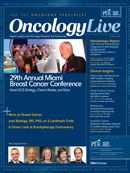Five Questions for Leonard M. Neckers, PhD
Leonard M. Neckers, PhD, has been studying the role of the molecular chaperone Hsp90 in signal transduction and the translational development of Hsp90-targeted anticancer agents for two decades.
Leonard M. Neckers, PhD
Chief, Tumor Cell Biology Section, Urologic Oncology Branch, National Cancer Institute, Rockville, Maryland
Leonard M. Neckers, PhD, is chief of the Tumor Cell Biology Section, Urologic Oncology Branch of the National Cancer Institute, Rockville, Maryland. His lab has been studying the role of the molecular chaperone Hsp90 in signal transduction and the translational development of Hsp90-targeted anticancer agents for two decades. Research conducted in his laboratory uncovered the importance of Hsp90 in the growth and survival of cancer cells and led to the first clinical trials of Hsp90 inhibitors.
1
What role does Hsp90 play in normal cells?
Molecular chaperones help nascent polypeptides fold correctly and multimeric protein complexes assemble productively, while minimizing the danger of aggregation in the protein-rich intracellular environment. Heat shock protein 90 (Hsp90) is an evolutionarily conserved molecular chaperone that participates in stabilizing and activating more than 200 proteins— referred to as Hsp90 “clients”—many of which are essential for constitutive cell signaling and adaptive responses to stress. To accomplish this task, Hsp90, the chaperone Hsp70, and additional proteins termed co-chaperones form the dynamic complex known as the Hsp90 chaperone machine.
2
How is Hsp90 implicated in the development of cancer?
Cancer cells use the Hsp90 chaperone machinery to protect an array of mutated and overexpressed oncoproteins from misfolding and degradation. Hsp90 is recognized as a crucial facilitator of oncogene addiction and cancer cell survival.
3
How has the role of Hsp90 been exploited in cancer research and drug development?
Like the prototypic Hsp90 inhibitor geldanamycin (which was identified in 1994), Hsp90 inhibitors currently under clinical evaluation interact with Hsp90’s N domain ATP-binding pocket, prevent ATP binding, and stop the chaperone cycle, leading to client protein degradation.
Hsp90 inhibitors have proven to be very useful as probes of Hsp90 function in both normal and cancer cells. Progress has been made in the clinical evaluation of targeting Hsp90 in cancer. Patient selection based on tumor molecular characterization indicating heightened dependence on Hsp90 and sensitivity to Hsp90 inhibition is proving fruitful, as exemplified by RECIST responses in a recent clinical trial involving patients whose non-small cell lung cancers expressed EML4-ALK fusion protein, and in a trial involving HER2-positive breast cancer patients.
Another strategy that has shown promising results is the combination of Hsp90 and proteasome inhibitors to treat multiple myeloma. The first Hsp90 inhibitor, 17-AAG (tanespimycin), entered clinical trials in 1999. In 2004, a second Hsp90 inhibitor, 17-DMAG (alvespimycin), entered a first-in-human study. Owing to extensive efforts in rational drug design and discovery, 13 additional Hsp90 inhibitors are currently undergoing clinical evaluation in cancer patients. Ten of these agents have entered the clinic in the past three years.
4
Can Hsp90 be used as a biomarker or prognostic indicator in cancer?
Numerous published studies have reported elevated Hsp90 expression to be a characteristic of cancer cells in vivo. Further, a recent study reported a significant inverse correlation between prolonged survival and tumor Hsp90 level in patients with non-small cell lung cancer. Studies are now in progress to confirm the link between tumor Hsp90 expression and tumor grade.
5
What is the future of research with regard to our understanding of Hsp90 or the development of Hsp90-targeted cancer therapy?
Although many Hsp90 clients are oncogenes, and many of the compensatory mechanisms used by tumors to overcome other molecularly targeted and cytotoxic therapies are vulnerable to Hsp90 inhibition, it is now apparent that Hsp90 is also a key regulator of host cell biology at the systems level. These systemic effects can either enhance or antagonize the antitumor activity of Hsp90 inhibitors in cancer patients.
Studies of the impact of targeted therapy in oncology trials have tended to focus on the predicted effects of the drug on the tumor without consideration of the impact of therapy on the host, and the evaluation of Hsp90 inhibitors is no exception. As we move forward in developing these agents, it will be critically important to consider the impact of Hsp90 inhibitors on the patient as well as on the tumor, in order to identify the most fruitful indications for Hsp90 inhibitor therapy in oncology.




